The week at a glance
- Yelkouan Shearwaters in Cornwall
- Little Shearwaters in Cornwall and Cheshire
- Probable Fea's Petrel in Co Mayo
- House Crow in Co Cork
- Roller in East Yorkshire
- Eastern Olivaceous Warbler in Shetland
- Possible Iberian Chiffchaff in Northumberland
- Zitting Cisticola in Kent
- Swainson's Thrush in Shetland
- House Finch still in Devon
The good run of seabirds continued this week, with another Yelkouan Shearwater past Porthgwarra (Cornwall) on 9th, two further 'possibles' on 12th and another possible on 15th. Cornwall also scored with a probable Little Shearwater past Pendeen (Cornwall) on 9th, and a more definite sighting occurred past Meols (Cheshire) on 14th, also seen 15 minutes later past Hoylake. This is only the third record for Cheshire — and the first healthy one — following a sick bird picked up at Rostherne Mere in 1977 and a moribund bird found near Stockport in 1958. Last of the rare seabirds was a probable Fea's Petrel past Kilcummin Head (Co Mayo) on 15th.
Following the report of a possible House Crow in Cobh (Co Cork) last week (glimpsed by a birder with no bins), it was finally confirmed on 12th. It then spent the rest of the week showing incredibly well around the centre of Cobh. Interestingly House Crow is already on the Irish List, but only as a category D species following a record in 1974.
House Crow, Cobh, Co Cork (Film: limosawit).

House Crow, Cobh, Cork (Photo: Ronan McLaughlin)
Over in the east, news emerged of an immature Roller at Easington (East Yorkshire) on 12th. The county recorder had been sent an email with two photographs of the bird, but with scant detail. It turns out the bird was seen, photographed and videoed by two workers at the Easington gas terminal, obviously a strictly private site. Video of the bird did appear on YouTube, but was quickly removed... It was still present on Monday but, with neither of the finders working on Tuesday, no extra news came out. It also hit the headlines, making an appearance on the local Look North news.
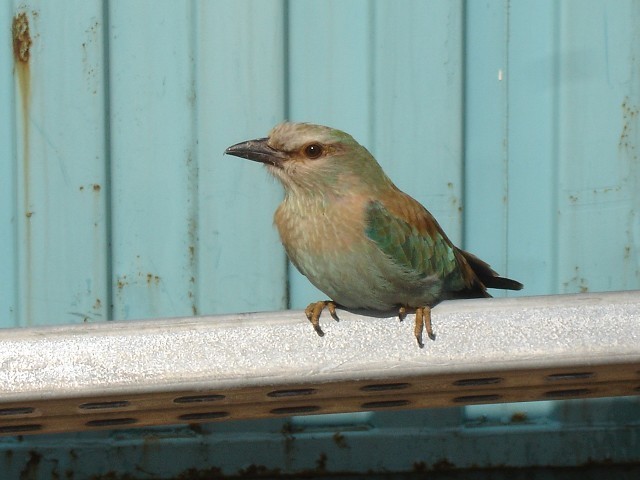
European Roller, Easington, East Yorkshire (Photo: Dan Adams and Brian Napierski)
Other mega passerines were another Eastern Olivaceous Warbler, at Ireland (Shetland) for just one day on 12th. This is the third consecutive year the islands have turned up this species. There was a possible Iberian Chiffchaff at Hadston Carrs (Northumberland) on 12th, though further details were limited.

Eastern Olivaceous Warbler, Ireland, Mainland, Shetland (Photo: Hugh Harrop)
One of the most interesting records of the week was the appearance/reappearance of a/the Zitting Cisticola at Pegwell Bay (Kent) on 9th. Presumably this is the same bird that was first seen at the site over 6th September–12th December 2009 and then again on 1st April 2010. Has it really been at the site now for over a year?
With so many Nearctic non-passerines turning up it was only a matter of time before the first passerine appeared. As has often been the case in recent years, this was in the north: a Swainson's Thrush was found on Fair Isle (Shetland) on 15th, though it was very elusive. This is the second record for the island (and sixth for Shetland), following a bird in 1990.
As ever, bringing up the rear, the male House Finch was at East Prawle (Devon) to at least 12th.

House Finch, East Prawle, Devon (Photo: Pat Mayer)
With weather systems from the west, we were expecting a few early geese to start arriving this week. The only flock of note so far, though, were 85 Pale-bellied Brent Geese past Rubha Ardvule, South Uist (Outer Hebrides) on 13th. Perhaps of less note were the Ruddy Shelduck with Greylag Geese at Cley (Norfolk) on 11th and the two at Rockcliffe Marsh (Cumbria) on 14th. Have the larger groups from last month now moved on or are they just not being reported?
Other long-standing features included the drake Ferruginous Duck at Chew Valley Lake (Somerset) all week, with others at Pitsford Reservoir (Northamptonshire) still to 11th and a probable at Cosmeston Lakes (Glamorgan) on 10th. Two possibles at Stoke Newington Reservoirs (London) on 14th eventually turned out to be hybrids. Some debate also centred around the Marbled Duck at Broom Gravel Pits (Bedfordshire), which only stayed to early on 9th.
The week saw the return of the drake Ring-necked Duck, relocated at Achill Island (Co Mayo) on 14th, with a new bird found at Chew Valley Lake (Somerset) on 13th. Also from the west, juvenile Blue-winged Teal were at Shannon Airport Lagoon (Co Clare) on 12th and Tacumshin (Co Wexford) on 13th.
The first-winter drake King Eider that has wandered around the North Sea ventured as far south as Suffolk this week. It was first seen drifting south past Kessingland (Suffolk) on the morning of 12th and was then seen off Minsmere, Dunwich Cliffs and Sizewell to 15th. It represents the first record for the county.
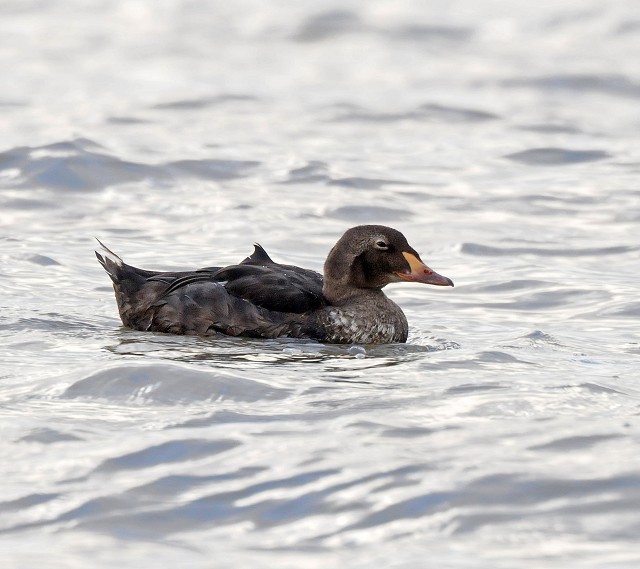
King Eider, Dunwich Cliffs, Suffolk (Photo: Jon Evans)
There was some stunning seawatching to be had from Bridges of Ross (Co Clare) during the week. The 11th saw Wilson's Petrel, Great Shearwater, six Sabine's Gulls, 35 Grey Phalaropes and 170 Leach's Petrels, and a 45-minute seawatch on 14th produced no fewer than 37 Sabine's Gulls, along with 180+ Leach's Petrels, 11 Pomarine Skuas, 35 Grey Phalaropes and 130 Sooty Shearwaters!
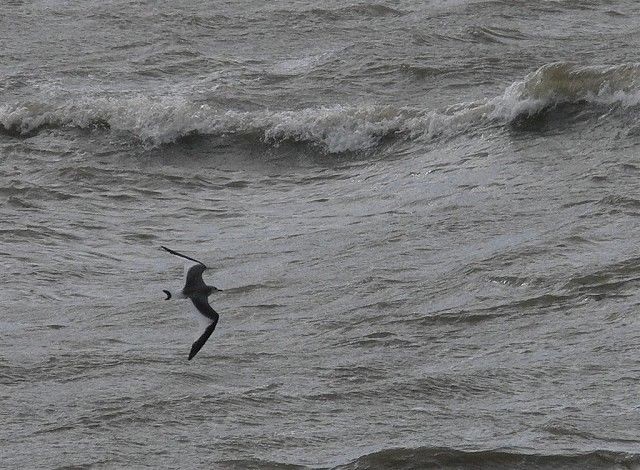
Sabine's Gull, Crosby, Lancashire (Photo: Gavin Thomas)

Grey Phalarope, at sea, Scilly (Photo: Joe Pender)
Other records of big shearwaters were few and far between, with just one Great Shearwater past Cape Cornwall (Cornwall) on 15th and Cory's Shearwaters reported past Turnberry Point (Ayr) on 11th and Bardsey (Gwynedd) on 12th. Bardsey also recorded 77 Sooty Shearwaters on the same date, with the only other big counts being 100 past Kilcummin Head (Co Mayo) on 15th and 60 past Tarbat Ness (Highland) on 12th. Balearic Shearwater numbers peaked at 74 past Gwennap Head (Cornwall) on 10th and 22 past Portland (Dorset) on 9th.
The influx of Glossy Ibis continued and the flock of 20 birds remained on the Otter estuary (Devon) to 12th, though only 16 were seen going to roost. The next day, a group of 16 headed east past Beer (Devon) early in the morning, and by 18:00 a group of 18 arrived at Dungeness (Kent). These may have been part of the same group, though the presence of colour-ringed birds should help clear this up. At least 16 of these birds then stayed in the area to 15th. To confuse matters, two birds appeared to stay on the Otter estuary to 15th; four were also seen over Boscastle (Cornwall) on 9th, a group of five were seen over Pegwell Bay (Kent) on 9th and a juvenile was at Aveton Gifford (Devon) on 12th–15th. In Ireland, one was still at Tacumshin (Co Wexford), reported on 9th, and two were at Lady's Island Lake (Co Wexford) on 12th.

Glossy Ibis, Budleigh Salterton, Devon (Photo: Charlie Fleming)
Two White Storks were reported south over Northwick Warth (Gloucestershire) on 12th, with a juvenile at New Romney (Kent) on 14th–15th. There was also a roving juvenile Black Stork in Scotland. It was reported at Kyle of Lochalsh (Highland) on 9th and a bird at Cromdale (Highland) on evening of 9th–10th was photographed by the father of a friend of a birder, who later identified the bird.
The Great White Egret remained at Dungeness (Kent) to 13th, and others were seen over Oxey Marsh (Hampshire) on 9th, in the Idle Valley (Nottinghamshire) on 10th–15th, roosting at Dryslwyn (Carmarthenshire) on 9th and at Calvert Lakes (Buckinghamshire) on 15th. The only Cattle Egret reported was one again at Kingfisher's Bridge (Cambridgeshire) on 14th–15th and new in was a Squacco Heron at Kilnsea (East Yorkshire) on 15th.

Squacco Heron, Kilnsea, East Yorkshire (Photo: Andy Hood)
Away from East Anglia, Spoonbills were seen in Chichester Harbour (West Sussex) on 10th and at Thorney Deeps (West Sussex) on 11th–12th, with two at Isley Marsh (Devon) on 10th–11th.
On the raptor front, the White-tailed Eagle was on the Farne Islands (Northumberland) on 11th, a Black Kite was seen over Stubbington (Hampshire) on 12th and there were a few Red-footed Falcons. One over Belton (Norfolk) on 12th could well have been the same as at Dunwich Heath (Suffolk) on 12th, which then passed Sizewell (Suffolk) half an hour later. A male was then over Stoke Newington Reservoirs (London) on 12th, with a juvenile reported over Tower Hamlets (London) on 14th.
Spotted Crakes remained at Willington Gravel Pits (Derbyshire) to 9th, Shibdon Pond (Durham) to 11th and Radley Gravel Pits (Oxfordshire) to 12th, and the only new bird was at Porth Hellick, St Mary's (Scilly) on 15th.
The only migrant Dotterel reported were an adult at Beacon Ponds (East Yorkshire) on 11th and a juvenile at Polgigga (Cornwall) on 11th–12th. American Golden Plovers were again at Clachan, North Uist (Outer Hebrides) to 9th, Loch Gruinart (Argyll) to 12th and North Ronaldsay (Orkney) to 12th. New in were birds at Loch Bee, South Uist (Outer Hebrides) on 11th and Pool of Virkie (Shetland) on 12th.
The influx of Buff-breasted Sandpipers continued, with small groups and singles at many sites. The flock at Ballycotton (Co Cork) remained to 13th, peaking at eight birds on 10th. Up to six were at Tacumshin (Co Wexford) over 10th–14th with up to four on the airfield on St Mary's (Scilly) to 15th. In Ireland, birds were at Sherkin Island (Co Cork) on 10th, Lissagriffin (Co Cork) to 14th, Achill Island (Co Mayo) on 11th — with two on 14th — and at Loop Head (Co Clare) on 11th. On the Outer Hebrides, two were at Loch Bee, South Uist on 11th–13th, with singletons at The Range, South Uist on 14th and at Butt of Lewis on 14th–15th. Elsewhere, other singles were on Fair Isle (Shetland) on 15th, Davidstow Airfield (Cornwall) on 11th–15th, Northam Burrows CP (Devon) on 12th–15th, Abberton Reservoir (Essex) on afternoon of 12th, L'Ancresse Common (Guernsey) on 12th–15th with a probable on Blyth estuary (Suffolk) on 10th. The place to be, though, was Leam Lough (Co Mayo), which held Spotted Sandpiper and White-rumped Sandpiper on 10th, joined by a Buff-breasted Sandpiper and two juvenile Pectoral Sandpipers on 11th (with one remaining to 14th).
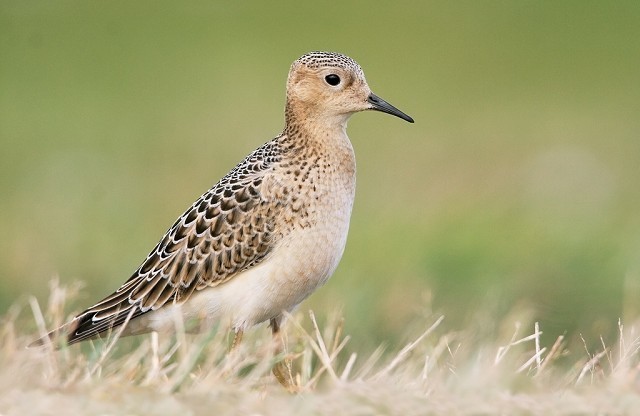
Buff-breasted Sandpiper, L'Ancresse Common, Guernsey (Photo: Chris Bale)
Other Pectoral Sandpipers were too numerous to mention, with as many as 38 birds reported. Most were singles, but the group at Pitsford Reservoir (Northamptonshire) increased to three on 12th–15th, three more were at Lough Beg (Co Antrim) on 12th with two at Carrahane Strand (Co Kerry) on 12th and two at Loch Bee, South Uist (Outer Hebrides) on 12th. Singles were widely spread on all coasts. In the east, birds were in East Sussex, Kent, Essex, Norfolk and Lincolnshire. The northeast saw fewest, with birds at Budle Bay and Low-Newton-by-the-Sea (Northumberland). In Scotland, birds were in Lothian, Perth & Kinross, Argyll and Shetland, and in Ireland were in Co Antrim, Co Mayo, Co Cork, Co Waterford and Co Clare. The southwest also did poorly, with singles in Pembrokeshire, Cornwall, Scilly, Gloucestershire and Dorset. The only land-locked counties to score were Northamptonshire, with the bird remaining at Pitsford Reservoir to 15th, and Cambridgeshire, with birds on Ouse Washes on 12th and Paxton Pits on 14th.
The first Upland Sandpiper of the year was reported on St Martin's (Scilly) on 10th. This period also brought a juvenile White-rumped Sandpiper to Valtos, Lewis (Outer Hebrides) on 10th and a juvenile Lesser Yellowlegs at Achill Island (Co Mayo) on 11th. Later in the week, a Spotted Sandpiper was at Porth Hellick, St Mary's (Scilly) on 14th–15th and a possible Dowitcher sp. flew past Minsmere (Suffolk) on 14th.

Lesser Yellowlegs, Achill Island, Mayo (Photo: Derek Charles)

Spotted Sandpiper, St. Mary's, Scilly (Photo: Martin Goodey)
Other wader interest came in the form of the Semipalmated Sandpipers that remained at Tyninghame Bay (Lothian) to 15th, a Broad-billed Sandpiper on the beach at South Gare (Cleveland) on 10th, relocating to Seaton Snook on 11th–12th, and a Great Snipe on Foula (Shetland) on 11th–14th.
All three phalaropes were reported, with Red-neckeds remaining at Slimbridge (Gloucestershire) to 12th and Holme NOA (Norfolk) to 12th and new birds at Farlington Marsh (Hampshire) on 12th and Carr Beds (Cumbria) on 15th. Grey Phalaropes were widespread, with singles past sites in Orkney, Outer Hebrides, Co Down, Glamorgan and Dorset, three from a Scilly pelagic on 13th and inland birds at Eglwys Nunydd Reservoir (Glamorgan) on 13th–14th (two on 15th), and one at Grimley (Worcestershire) on 15th. Ireland saw the biggest numbers, though, with the peak being an incredible 69 past Kilcummin Head (Co Mayo) on 15th. The Wilson's Phalarope remained on Great Pool, Tresco (Scilly) to 14th and new in were a juvenile at Grove Ferry (Kent) on 9th–11th and at Gibraltar Point (Lincolnshire) on 13th–15th (with a Pectoral Sandpiper there on 13th–14th).
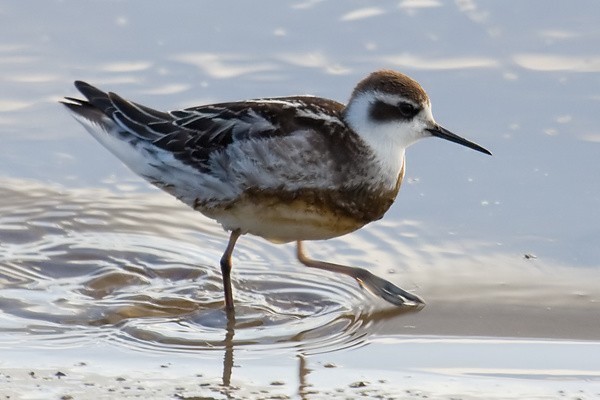
Red-necked Phalarope, Carr Beds, River Eden, Cumbria (Photo: Darren Robson)

Grey Phalarope, Eglwys Nunydd Reservoir, Glamorgan (Photo: C Baker)

Wilson's Phalarope, Gibraltar Point NNR, Lincolnshire (Photo: Neil Loverock)
Big gulls were poorly represented, with an adult Glaucous Gull at Ardivachar Point, South Uist (Outer Hebrides) on 10th, the immature still at Youghal (Co Waterford) on 12th and the over-summering second-winter Iceland Gull again at Gortnagarryan Strand (Co Mayo) on 11th. The American Herring Gull was reported again at Blennerville (Co Kerry) to 15th and there were Ring-billed Gulls at Prescot Reservoirs (Lancashire) on 10th, Portrush (Co Antrim) on 14th and Black Rock Strand (Co Kerry) on 12th. The Dorset bird relocated to Coward's Marsh on 9th–12th, but was back at Stanpit on 13th and at Sopley on 15th. The wandering Bonaparte's Gull was again in the northeast, at Whitburn Steel (Durham) on 11th.
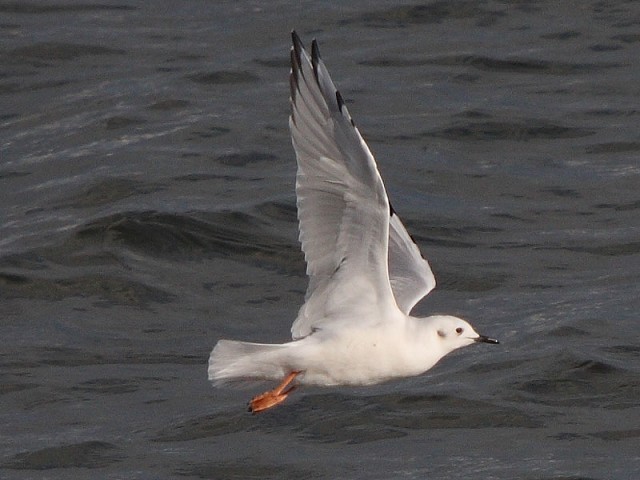
Bonaparte's Gull, Whitburn Steel, Durham (Photo: Mark Newsome)
In addition to the massive count mentioned previously, an even more impressive 51 Sabine's Gulls passed Kilcummin Head (Co Mayo) on 15th, with smaller numbers at various sites including Dungeness (Kent) and Pendeen (Cornwall) on 11th, Loop Head (Co Clare) on 13th and one from a boat off Staffin Bay, Skye (Highland) on 12th. The 14th saw birds off Coll (Argyll), Calf of Man (Isle of Man), Point Lynas (Anglesey) and Rossall Point (Lancashire) and by 15th birds were recorded in Clwyd, Co Donegal, Lancashire, Argyll, Anglesey, Gwynedd and Cheshire. Higher counts were three past Strumble Head (Pembrokeshire) on 12th (also 4 Long-tailed Skuas and 24 Balearic Shearwaters), two past Rubha Ardvule, South Uist (Outer Hebrides) on 12th with others on 13th and 14th (also 13 Leach's Petrels, 9 Grey Phalarope and 2 Sooty Shearwaters), six past Ramore Head (Co Antrim) on 14th and six past Pendeen (Cornwall) on 15th.
The Whiskered Tern remained at Rutland Water (Leicestershire) to 15th, as did the White-winged Black Tern at the same site. Other WWBTs were at Grafham Water (Cambridgeshire) on 10th–13th, at Cresswell Pond (Northumberland) on 15th, and a probable at Oxey Marsh (Hampshire) was probably the same as at Hurst Castle (Hampshire) 45 minutes later
The female Snowy Owl was again at Blacksod (Co Mayo) on 10th and there was a report of one at Valtos, Lewis (Outer Hebrides) 'recently'.
Wrynecks were still very widespread across the country, and we received 178 reports during the week (some referring to the same birds though). With many in gardens it wasn't surprising to find one hitting a window/car at Nailsworth (Gloucestershire) and brought in by a cat, another killed by a cat at Killingworth (Northumberland) and one rescued from a cat at Sherborne (Dorset).
There were single records of Hoopoe, at Dungeness (Kent) on 14th, Short-toed Lark, on Fair Isle (Shetland) on 10th, Red-rumped Swallow, at Lyminster (West Sussex) briefly on 12th, and Tawny Pipit, at Cotswold Water Park (Gloucestershire) on 13th (in an area with no access).
The run of Citrine Wagtail records continued, and after a possible first-winter reported on South Gare (Cleveland) on 10th, others were reported again from St Agnes (Scilly) on 10th, possibly the same on St Mary's on 12th–13th, on North Ronaldsay (Orkney) on 10th and at Coonagh (Co Limerick) on 12th–14th. A smart male Grey-headed Wagtail was at Girdle Ness (Aberdeenshire) on 9th, with four on Fair Isle (Shetland) on 9th.
The Lesser Grey Shrike remained on St Mary's (Scilly) to 13th and the Woodchat Shrike was at Three Castles Head until 15th. In a good week for shrikes, Hampshire's first Daurian Shrike — a rather distinct race of Isabelline Shrike — was at Gosport on 10th–11th. It seemed that most Red-backed Shrikes had passed through, with fewer reports this week than last. The Northern Isles again had the lion's share, with numerous birds on Shetland at the weekend. Others were in Orkney, Northumberland, Durham, Cheshire, Norfolk, Suffolk, Hampshire, Devon and Cornwall. Great news came from Dartmoor (Devon) as well, as it was confirmed that a pair had successfully bred there, despite the attentions of egg collectors. More details are in the webzine, but note that it appears that a pair fledged three young in Yorkshire in 2009, hence this recent pair aren't the first to breed since 1992.

Isabelline Shrike, Gosport, Hampshire (Photo: Phil Wallace)
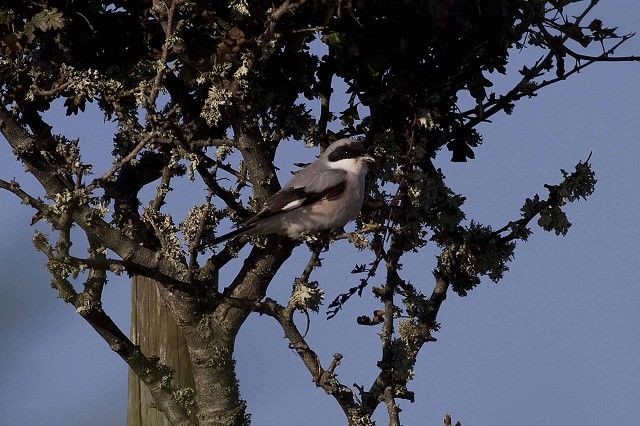
Lesser Grey Shrike, St. Mary's, Scilly (Photo: Joe Pender)
A late Aquatic Warbler was seen on the ARC pit at Dungeness (Kent) on 10th, and a Paddyfield Warbler at Quendale (Shetland) on 10th was the fourth (or fifth?) of the year, all of which have so far been on Shetland. Barred Warblers were again widespread, with almost 50 reports received. As with Wryneck, Shetland saw most records, including three on Fair Isle on 9th, two on Whalsay on 11th and two on Foula on 12th. Furthest south were birds in Suffolk at Minsmere and Landguard on 9th. Icterine Warblers were fewer in number, with birds in Shetland, Aberdeenshire, Fife, North and East Yorkshire, Gwynedd, Norfolk, Suffolk, Dorset and East Sussex. In Ireland, birds were at Mizen Head (Co Cork) and Hook Head (Co Wexford). The only Melodious Warblers were predictably in the west: at Old Head of Kinsale (Co Cork) to 9th and at Porthgwarra (Cornwall) on 10th–11th.

Icterine Warbler, Isle of May, Fife (Photo: Alex Ash)
Three Western Bonelli's Warblers were a nice addition to the week, at Brough, Whalsay (Shetland) on 9th–15th, on North Ronaldsay (Orkney) on 10th–11th (ringed on the latter date) and at Bempton Cliffs (East Yorkshire) on 11th–12th. Other Phylloscs included Greenish Warblers at Newbiggin-by-the-Sea (Northumberland) to 10th and one ringed on Isle of May (Fife) on 10th, and the Arctic Warbler remained at Holme (Norfolk) to 15th. The first Yellow-browed Warbler of autumn was on Whalsay (Shetland) on 11th, with another at Lerwick (Shetland) on 13th.

Western Bonelli's Warbler, Bempton Cliffs RSPB, East Yorkshire (Photo: Steve Race)

Arctic Warbler, Holme NOA, Norfolk (Photo: Penny Clarke)
The first vague signs of winter arrived, with a Fieldfare at East Dereham (Norfolk) on 9th and a Twite with Goldfinches at Gramborough Hill (Norfolk) on 9th. There were also three Fieldfares and a Redwing on Fair Isle (Shetland) on 9th, and Snow Buntings at Spurn (East Yorkshire) on 11th and at Cross Lough (Co Mayo) on 14th.
There was another juvenile Rose-coloured Starling this week, at Thurlestone (Devon) on 13th–14th. It might still be a bit early for Bluethroats, with the only birds on the Isle of May (Fife) on 10th, on the Farne Islands (Northumberland) on 11th and on Foula (Shetland) on 12th. Foula also held the only Thrush Nightingale, seen on 11th.
Red-breasted Flycatchers continued to be found in good numbers, with birds on South Ronaldsay (Orkney) on 9th, at Sammy's Point (East Yorkshire) again on 9th, on Whalsay (Shetland) on 9th–10th, at Loftus (Cleveland) on 10th, Sandwick (Shetland) on 10th, Quarff (Shetland) on 10th, Whalsay (Shetland) on 11th and, further south, at Newlyn (Cornwall), reported on 13th
Common Rosefinches were well recorded in the north, with up to three at Otterswick, Yell (Shetland) on 10th. Aside from the 13 on Shetland and three on Orkney, two were still at Spurn (East Yorkshire) on 9th with one on 13th, one was on St Mary's (Scilly) on 15th and one was on Skomer (Pembrokeshire) on 15th.
The tail end of the influx of Ortolan Buntings left singles still in Nanquidno Valley (Cornwall) on 9th and on the Farne Islands (Northumberland) on 11th. Others were at Grutness (Shetland) on 10th–12th, Beachy Head (East Sussex) on 11th–12th, Whalsay (Shetland) on 12th and Mull of Oa, Islay (Argyll) on 15th. Lapland Buntings were also less widespread, although a 'vis-mig' count of 275 (including a flock of over 60) at Aird an Runair, North Uist (Outer Hebrides) and 148 on Fair Isle (Shetland) on 11th were still notable, to say the least! Last, but not least, was the Little Bunting that was again on the Isle of May (Fife) on 9th.

Little Bunting, Isle of May, Fife (Photo: Alex Ash)
Just out of interest, some of the best migration counts from the week included 155 Chiffchaffs, 120 Blackcaps and 26 Wheatears at Durlston (Dorset) on 12th, 18,000 Swallows and 15,000 Meadow Pipits at Spurn (East Yorkshire) on 9th and 15th respectively and 20,000 Swallows, 1,000 Sand Martins, 70 Yellow Wagtails and 16 Sparrowhawks at Dungeness (Kent) on 12th. This doesn't quite compare to what might arrive, though, with a count of 99,500 Chaffinches and 27,290 Siskin over Falsterbo in southern Sweden on 12th hinting at the numbers of birds out there.
Photo of the Week: 9th—15th September
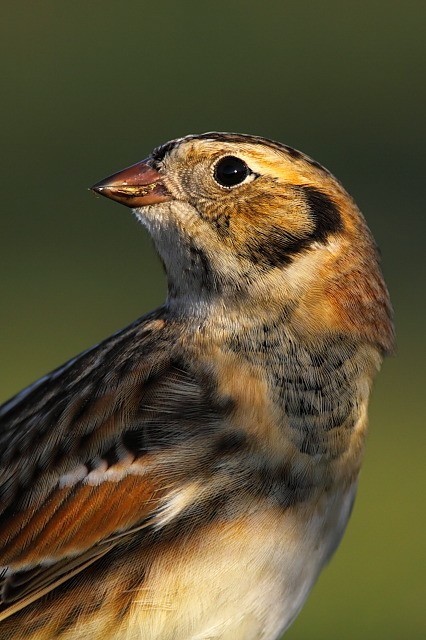
Lapland Bunting, Land's End, Cornwall (Photo:
Lewis Thomson)
Sometimes, bird photography is about simply 'capturing' an inherently compelling avian subject or event; other times, though, it involves 'creating' an image when there is very little to work with. At this time of year, many bird photographers would regard Lapland Buntings as Little Brown Jobs of the worst kind — ones that spend all their time on rough ground, limiting photo opportunities to mere record shots. A closer look at these delightful birds, though, reveals the intricate plumage details that help them blend into their surroundings. However, to bring out these details, the bird needs to be isolated from its typical setting, with lighting that brings out the colours and tones of the plumage. This is exactly what Lewis Thomson achieved when he came across one of these birds at Land's End, Cornwall. Lewis got down low enough to set the bird against a complementary background that could be blurred by the wide aperture and long focal length of the lens. Then, shooting with warm, early-evening sunlight coming from behind him, Lewis managed to catch the bunting in an engaging pose, with added interest coming from the dappled shadows. Using a tight, well-composed crop with high contrast and colour saturation, Lewis proves that, with the right approach, you really can create a silk purse from a sow's ear.
Other notable photos

Osprey, Aviemore, Highland (Photo:
Terry Cavner)
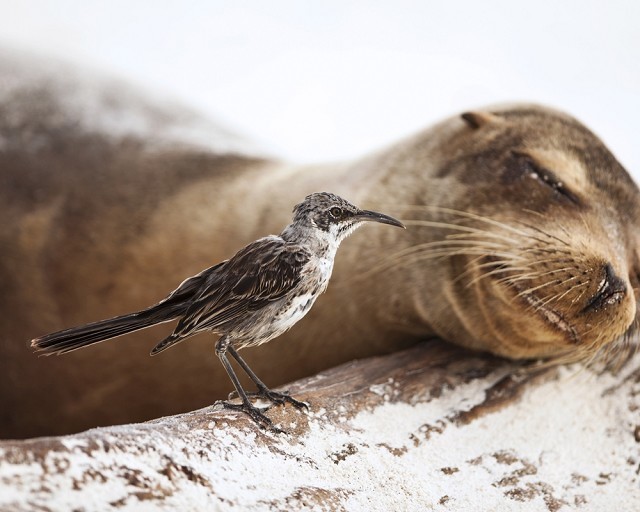
Hood Mockingbird, Ecuador (Photo:
Polina Kasapova)
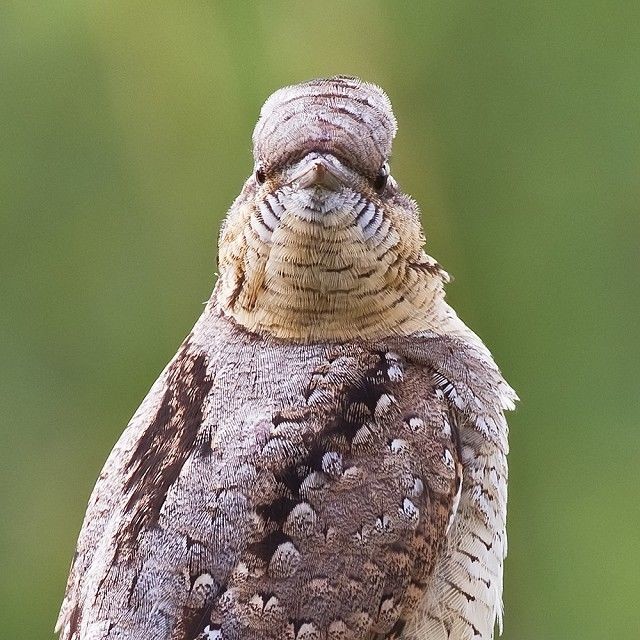
Wryneck, Holland Haven CP, Essex (Photo:
Garth Peacock)

Common Kingfisher, undisclosed site, Worcestershire (Photo:
Tom Melton)
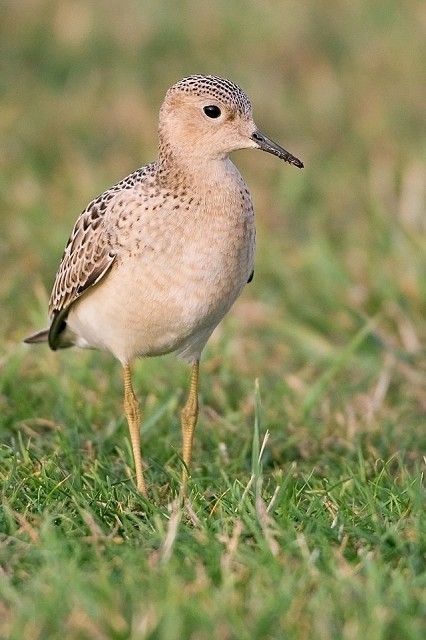
Buff-breasted Sandpiper, L'Ancresse Common, Guernsey (Photo:
Chris Bale)

Secretary Bird, Kenya (Photo:
Nigel Forrow)

Northern Wheatear, Malvern Hills, Worcestershire (Photo:
Carl Day)

Spotted Flycatcher, Donna Nook, Lincolnshire (Photo:
Dean Eades)

Common Kestrel, Titterstone Clee Hill, Shropshire (Photo:
Jim Almond)

Sanderling, Minsmere RSPB, Suffolk (Photo:
Jon Evans)

House Martin, Salthouse, Norfolk (Photo:
David Whistlecraft)

Curlew Sandpiper, Ballycotton, Cork (Photo:
Ronan McLaughlin)

Willow Tit, Knypersley Reservoir, Staffordshire (Photo:
Steve Seal)

Sedge Warbler, Cley Marshes NWT, Norfolk (Photo:
Ben the Plumber)

Barn Owl, Doddington Pool, Cheshire (Photo:
Malc Wright)

Black Tern, Earlswood Lakes, Warwickshire (Photo:
Chris Cook)

